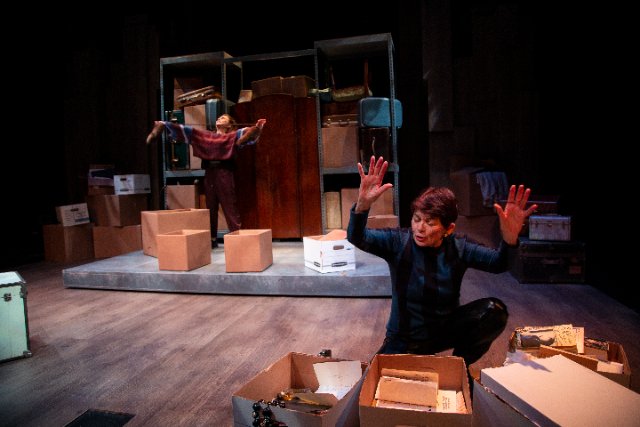Miriam and Esther Go To The Diamond District
A Mother's Death Brings Two Sisters Together
By: Victor Cordell - Jan 21, 2024
Before the era of saving everything imaginable on electronic media, physical mementos were often preserved - handwritten letters, photographs, financial and legal documents, manuscripts, vinyl record albums, memorabilia from life’s experiences like Playbills, and other collectibles. Upon a person’s death, one or more individuals, usually surviving family members, are often charged with foraging through the effects of the deceased to decide what to keep and what to trash. The process can be daunting, with the fear of possibly disposing something that is of financial worth or sentimental value to someone else close to the deceased. Some surprises may be positive, like an unexpected insurance policy or securities certificates. But there may also be revelations that the survivors wish had not been unearthed.
Playwright and Director Andrea Gordon’s self-referential world premiere deals with just such an event. Upon the death of their mother, two somewhat estranged sisters converge on the Upper West Side Manhattan apartment that had become their home when their father died and their mother moved them to New York City from Berkeley.
The overall narrative arc of the play is relevant and interesting, as are most of the specific events, but the script needs a sharper pen and insights from more pre-production readers. Modern playwrighting usually benefits from the number of processes that plays usually go through and from the numerous comments from participating artists along the way. One risk that is usually avoided is the playwright directing their own play, which eliminates what is typically the most useful dialog in script evaluation and production development. That caution is not exercised in this instance.
In Act 1 the sisters’ mother has died, and the women rifle through old artifacts, both reminiscing and reopening past wounds. Miriam (played by Ellen Brooks) is six years older than Esther (played by Janet Roitz). The gap is enough to argue that just based on age difference and birth order, that they grew up in different “families.” Indeed, so separated are they that Esther states to Miriam that the latter doesn’t even know her.
A specific incident reinforced their different family experiences. Both bridled under their mother’s second husband, an urbane and well-connected patron of the arts, who also domineered the girls in an unpleasant manner. Concerned about her own happiness, Miriam ran away from home as a teen, giving no thought to the consequences to Esther who was left to deal with the hostile environment on her own. As relationship fissures crack open during the search through artifacts, they also come upon letters written by their father, which prompt yet another reappraisal of their childhood.
The mother had been an opera singer, and the playwright uses dream flashbacks to introduce her and to suggest the sisters’ remembrances of their childhoods. The mother is played by Merrill Grant, who in the first act appears only twice, without speaking. Once she sings the opera aria “O mio babbino caro” which a daughter sings to her dying father in Puccini’s “Gianni Schicchi.” Later, she sings the “Embroidery aria” from Britten’s Peter Grimes, a song with dark themes that had oddly been used as a lullaby. The transitions into the dream sequences are unclear, but the good news is that Grant has a beautiful and powerful voice that stunned the opening night audience into appreciation.
In Act 2, the sisters continue to reveal more about themselves as well as their mother and both fathers. A flashback conveys the backstory of the blood parents. Included in the flashback is a nicely choreographed and danced pas de deux that seems a bit gratuitous, and its tone wavers uneasily between humorous and melodramatic.
This narrative is of considerable interest and one that many people will be able to relate to – at least in general, and for many, specifically. Deception and forgiveness play important roles. The personality differences between the women are well delineated, with Miriam being the steady, reliable one, and Esther being the easy-going Peter Pan. Even the deceased are well defined, especially the stepfather, who, like the father has his backstory exposed through letters found by the sisters. Creative elements and acting are sound.
The weakness of the production derives both from the script and the manner of delivery. The sisters get caught in the middle – neither sympathetic enough to evoke compassion or fractious enough to evoke discomfort. There are situations that could produce more energy if the sisters were more combative with one another, and points of bonding that could produce more empathy. Also, references to Valerie, a relative who had already picked over the belongings, don’t add anything to the drama.
Except from well established playwrights, premieres rarely emerge fully formed. This play elicits considerable interest and enjoyment. Hopefully it will benefit from strengthening the script and earn additional productions. A new title could even be considered. Although it is captivating, the story tells of the stepfather taking Miriam to the Diamond District when she is a teen, but there is no connection with Esther.
“Miriam and Esther Go To The Diamond District” written by Andrea Gordon, is produced by Rainbow Zebra Productions and plays at Magic Theatre, 2 Marina Blvd., Fort Mason Center, San Francisco, CA through January 28, 2024.





